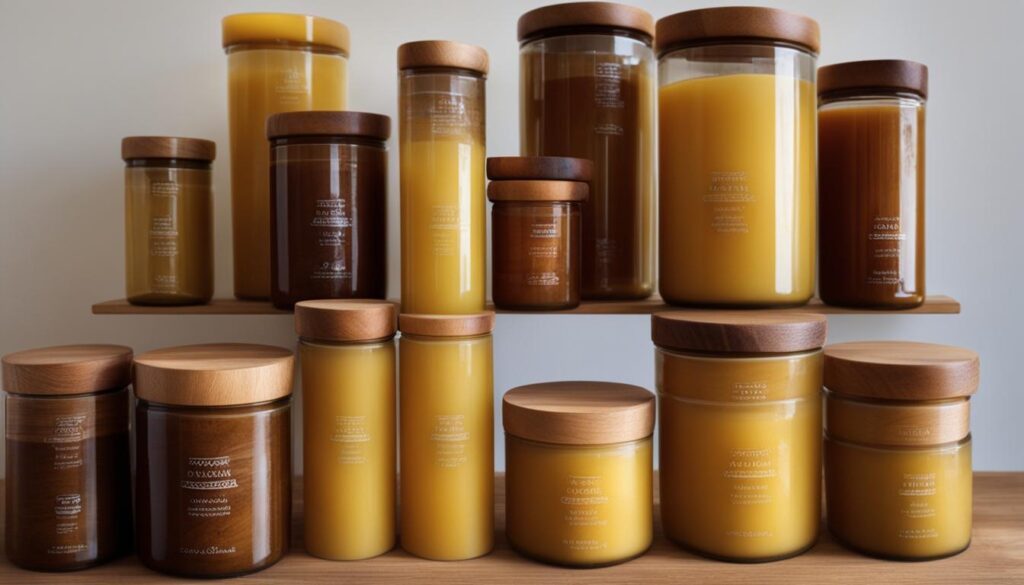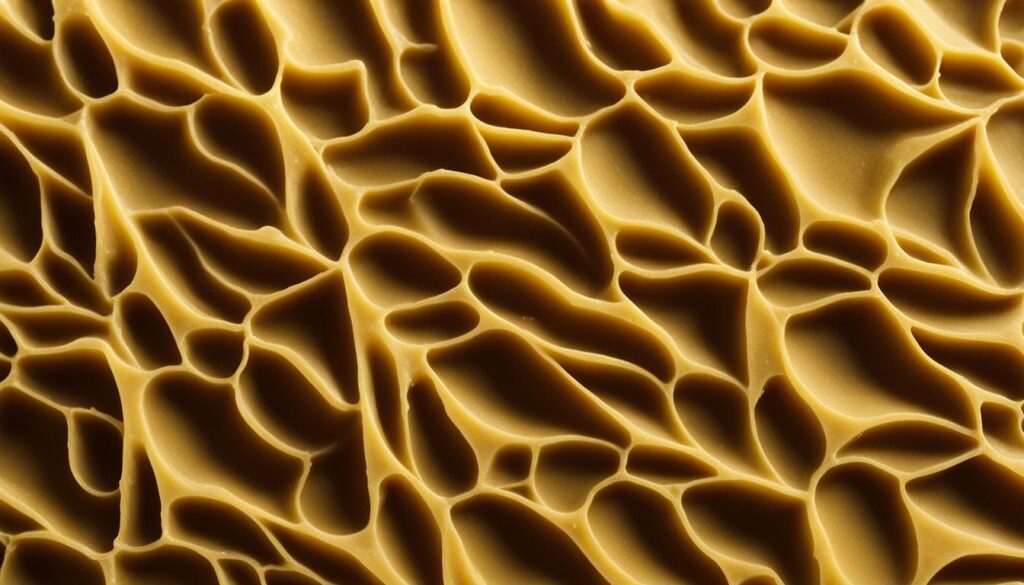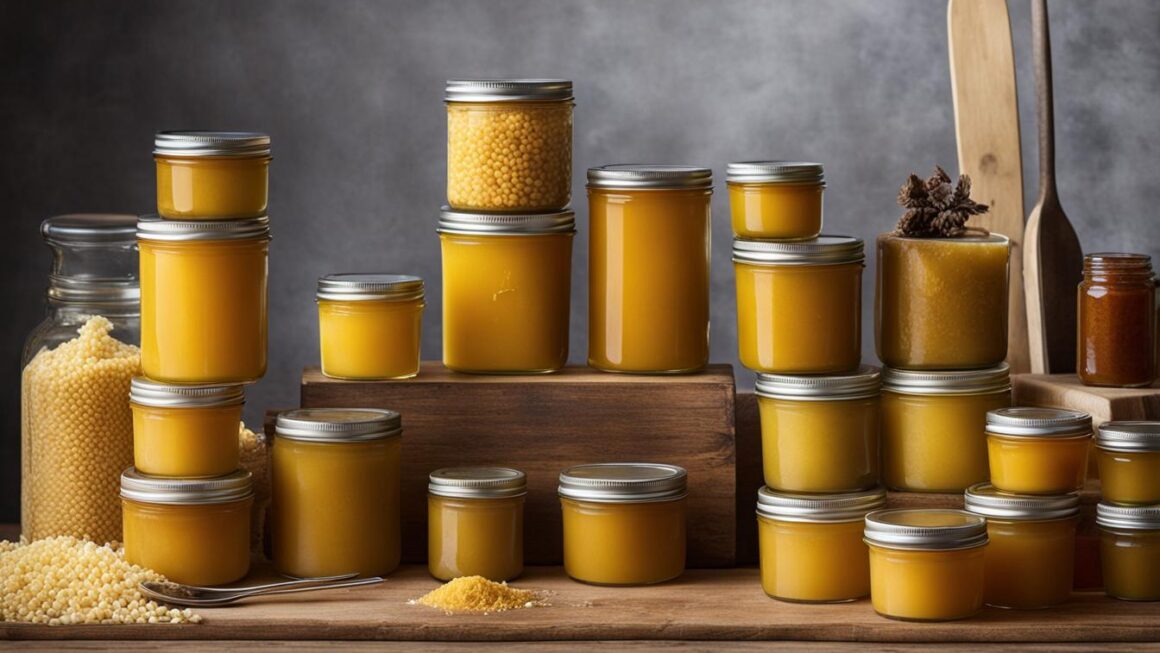Welcome to our informative article on the shelf life of beeswax! Beeswax is a versatile and valuable substance that has been used for centuries in various industries, from candle making to cosmetics and food packaging. Understanding the factors that affect the shelf life of beeswax and implementing proper preservation techniques can help prolong its usability and ensure its quality.
Unlike other types of wax, such as soy or palm wax, beeswax does not have a defined expiration date. As long as the wick in a beeswax candle is intact, the candle itself can last indefinitely. However, beeswax candles may develop a natural film-like substance called bloom over time, which is an indication of their purity. This frosted appearance can be easily polished off with a soft cloth, restoring the candle’s shiny appearance.
Beeswax has a high melting point and is insoluble in water but soluble in organic solvents. It is known for its use in cosmetics, providing elasticity and adhesiveness to products like lipsticks and creams. Additionally, beeswax is commonly used in food packaging and preservation due to its antifungal properties.
Key Takeaways:
- The shelf life of beeswax is indefinite as long as the wick is intact.
- Bloom, a frosted film-like substance that may develop on beeswax, is a natural occurrence indicating purity.
- Beeswax is used in cosmetics and food packaging due to its unique properties.
- Proper storage and handling can help maintain the freshness and usability of beeswax.
- Beeswax is insoluble in water but soluble in organic solvents.
Properties of Beeswax
Beeswax is a fascinating natural substance with unique properties that make it a versatile material used in various industries. Understanding the properties of beeswax is essential for extending its shelf life and ensuring its freshness.
Beeswax is a complex mixture of compounds secreted by honeybees. It contains over 300 different compounds, including hydrocarbons, esters of fatty acids, and long-chain alcohols. These compounds contribute to the plasticity and low melting point of beeswax. It is insoluble in water but soluble in organic solvents, which allows for its use in various applications.
With age, beeswax undergoes changes in color, odor, stiffness, elasticity, and hardness. These changes can be influenced by factors such as the production procedure, geographical conditions, and the type of honeybees used. Analyzing the physical properties of beeswax, such as its melting point and plasticity, can provide valuable insights into its freshness and usability.
Various techniques, including X-ray diffraction, Fourier transform infrared spectroscopy, scanning electron microscopy, and thermogravimetric analysis, can be used to characterize beeswax and understand its chemical composition. These analyses help ensure the quality and shelf stability of beeswax.
Table: Physical Properties of Beeswax
| Property | Description |
|---|---|
| Color | Varies depending on age and origin |
| Odor | Can change with age and storage conditions |
| Stiffness | Can become more rigid over time |
| Elasticity | May decrease with age |
| Hardness | Can vary depending on the age and origin of the beeswax |
Understanding the properties of beeswax is crucial for preserving its quality and freshness. By analyzing its physical and chemical characteristics, we can ensure that beeswax remains stable and usable for an extended period.
Beeswax Uses in Different Industries
Beeswax, with its versatile properties, finds numerous applications across various industries. Let’s explore some of the key industries where beeswax is commonly used.
1. Industrial Sector
In the industrial sector, beeswax serves multiple purposes. It is used as a hydrophobic insulator due to its resistance to water penetration. Beeswax is also utilized in the production of leather goods and shoes, providing them with a protective and durable finish. Additionally, its adhesive properties make it an ideal component in inks and varnishes, contributing to their effectiveness and longevity.
2. Food Packaging Industry
Beeswax plays a crucial role in the food packaging industry, particularly in the preservation of fruits and vegetables. It is used to create edible coatings that not only extend the shelf life of these perishable items but also help retain their moisture and freshness. The natural antifungal properties of beeswax contribute to keeping the produce safe and healthy for consumption.
3. Medical Field
In the medical field, beeswax finds application in the production of ointments, creams, and plasters. Its healing properties, along with its anti-inflammatory characteristics, make it a valuable ingredient in various medical formulations. Beeswax aids in soothing and protecting the skin, making it an essential component in skincare products and wound healing treatments.
4. Chewing Gum Production
Beeswax also plays a role in the production of chewing gums. It helps induce saliva secretion, enhancing the chewing experience. Additionally, beeswax contributes to the removal of dental stones, promoting oral health and hygiene.
5. Fine Arts and Crafts
Beeswax has been used in the production of fine bronze statues and gold ornaments through the lost-wax process. This technique involves creating intricate molds using beeswax, which is later replaced with molten metal, resulting in exquisite and detailed artworks.
These are just a few examples of the wide range of industries that benefit from the remarkable properties of beeswax. Its versatility and effectiveness in various applications make it a valuable and sought-after material in numerous fields.
Factors Affecting Beeswax Shelf Life
Preserving the quality and longevity of beeswax involves understanding the various factors that can influence its shelf life. These factors include the production procedure, the type of honeybees used, geographical conditions, and proper storage. Each of these elements plays a crucial role in determining the overall quality and freshness of beeswax.
The production procedure, including the method of wax extraction, can significantly impact the quality of beeswax. Different extraction methods may result in variations in color, odor, and overall purity. Similarly, the type of honeybees used in the production of beeswax can influence its physical properties and chemical composition.
Geographical conditions, such as climate and vegetation, can also affect the quality of beeswax. Beeswax produced in different regions may exhibit slight variations in color, hardness, and other characteristics. Understanding these geographical influences can provide valuable insights into the overall quality and authenticity of beeswax.
Proper storage is crucial for maintaining the shelf life of beeswax. Factors such as temperature, humidity, and exposure to light can impact its longevity. Beeswax should be stored in a cool, dark place to minimize heat and light exposure. Temperature fluctuations should be avoided to prevent any changes in the physical properties and chemical composition of beeswax. Additionally, storing beeswax in airtight containers can help protect it from moisture and air, ensuring its freshness and usability for an extended period.
Table: Factors Affecting Beeswax Shelf Life
| Factors | Impact |
|---|---|
| Production Procedure | Affects color, odor, and purity |
| Type of Honeybees Used | Influences physical properties and chemical composition |
| Geographical Conditions | Can result in variations in color and hardness |
| Storage Conditions | Temperature, humidity, and light exposure affect longevity |
By considering these factors and implementing proper preservation techniques, beekeepers and consumers can ensure the highest quality and freshness of beeswax, maximizing its shelf life and usability for a wide range of applications.
Preservation Techniques for Beeswax
Proper storage is key to preserving the shelf life and quality of beeswax. Follow these techniques to ensure your beeswax remains fresh and usable:
- Store in a cool, dark place: Beeswax should be kept away from heat and light, as exposure to these elements can cause the wax to deteriorate. Find a cool, dark spot in your home or workspace to store your beeswax.
- Airtight packaging: To prevent moisture and air from affecting the quality of your beeswax, store it in airtight containers or bags. This helps maintain its freshness and prevents any unwanted changes in texture or scent.
- Polish with a soft cloth: Over time, beeswax may develop a bloom, which is a natural film-like substance that forms on the surface. If you notice a bloom on your beeswax, simply polish it with a soft cloth to restore its shiny appearance.
By following these preservation techniques, you can extend the shelf life of your beeswax and ensure it remains in optimal condition for your various uses.

Table: Comparison of Beeswax Storage Techniques
| Storage Technique | Benefits | Considerations |
|---|---|---|
| Cool, dark place | Protects beeswax from heat and light | Avoid temperature fluctuations |
| Airtight containers | Prevents moisture and air exposure | Choose containers that seal tightly |
| Polishing with a soft cloth | Restores the shiny appearance of beeswax | Requires regular maintenance |
“Proper storage is key to preserving the shelf life and quality of beeswax.”
Implementing these preservation techniques will help maintain the freshness and usability of your beeswax. Remember to store it in a cool, dark place, use airtight packaging, and polish it with a soft cloth when needed. By taking these simple steps, you can ensure that your beeswax remains in optimal condition for all your beeswax-related projects and uses.
Analyzing the Shelf Stability of Beeswax
When it comes to the shelf stability of beeswax, there is good news for those who use this versatile natural material. Beeswax has excellent shelf stability, thanks to its chemical composition and physical properties. Unlike other types of wax, beeswax does not go bad or spoil over time. This makes it an ideal choice for various applications, from candles to cosmetics and even food packaging.
One of the factors contributing to the shelf stability of beeswax is its resistance to rancidity. Unlike vegetable-based waxes, such as soy or palm wax, beeswax does not have a specific expiration date. As long as the wick of a beeswax candle is intact, it can be used indefinitely without any significant changes in quality.
Furthermore, beeswax may develop a natural film-like substance known as bloom over time. This bloom, which appears frosted on the surface of beeswax candles, is an indicator of the purity of the wax. It does not affect the functionality or safety of the candle and can be easily removed by polishing the beeswax with a soft cloth. Proper storage and handling techniques, such as storing beeswax in a cool, dark place, can help maintain its freshness and usability for an extended period.
Analyzing the Chemical Composition of Beeswax
Beeswax is a complex mixture of compounds that plays a vital role in various industries. Its chemical composition consists of hydrocarbons, esters, fatty acids, alcohols, and unidentified compounds, which can vary depending on the origin and species of honeybees. Analyzing the chemical composition of beeswax provides valuable insights into its quality and freshness.
Techniques such as Fourier transform infrared spectroscopy (FTIR) can be used to analyze the chemical features of beeswax samples. FTIR measures the absorption of infrared light by the compound, creating a unique spectral signature that can be compared to reference libraries. This allows for the identification and quantification of the different compounds present in beeswax.
“The analysis of beeswax composition can help determine its purity and authenticity, ensuring its suitability for various applications.”
By understanding the chemical composition of beeswax, manufacturers and consumers can assess its purity and authenticity. This knowledge is particularly important in industries such as cosmetics, where the quality of beeswax directly impacts the performance of products like lipsticks and creams.
| Compound | Function |
|---|---|
| Hydrocarbons | Provide structural support and water resistance |
| Esters | Contribute to the scent and flavor of beeswax |
| Fatty Acids | Offer adhesive properties and stability |
| Alcohols | Affect the texture and consistency of beeswax |
| Unidentified Compounds | May have additional beneficial properties |
The chemical composition of beeswax provides a foundation for understanding its role in different applications. It allows for the development of tailored products that meet specific requirements, ensuring the highest quality and effectiveness.

Practical Applications of Analyzing Beeswax Composition
Understanding the chemical composition of beeswax can lead to innovative applications in various industries. For example, the identification of specific compounds responsible for the antimicrobial properties of beeswax can help improve food packaging and preservation techniques. Additionally, the analysis of beeswax composition can assist in developing sustainable and eco-friendly products in industries like cosmetics and pharmaceuticals.
By continuously analyzing the chemical composition of beeswax, researchers can uncover new insights and potential uses for this versatile substance. It enables the exploration of its full potential and the development of innovative solutions in multiple fields.
Evaluating the Physical Properties of Beeswax
Beeswax, a complex mixture of compounds secreted by honeybees, exhibits various physical properties that can provide valuable insights into its freshness and usability. Understanding these properties is essential for evaluating the quality of beeswax and ensuring its effectiveness in different applications.
One of the key physical properties of beeswax is its color, which can range from pale yellow to dark brown. The color of beeswax can be influenced by factors such as the type of honeybees used, geographical conditions, and the age of the wax. Odor is another important attribute of beeswax, with a mild, sweet aroma often associated with this natural substance.
The stiffness and elasticity of beeswax are also significant physical properties that can impact its functionality. Beeswax is known for its plasticity at low temperatures, allowing it to be easily molded and shaped. However, as the temperature increases, beeswax melts and becomes more malleable. This property makes it an ideal ingredient in various industries, such as candle making and cosmetics.
In addition to color, odor, stiffness, and elasticity, crystallization and hardness are also noteworthy physical properties of beeswax. Over time, beeswax may undergo crystallization, which can affect its texture and appearance. Hardness is another important characteristic, as it determines the firmness and strength of the wax. These properties are often evaluated to assess the quality and usability of beeswax in different applications.
Physical Properties of Beeswax:
| Property | Description |
|---|---|
| Color | Varies from pale yellow to dark brown |
| Odor | Mild, sweet aroma |
| Stiffness | Plasticity at low temperatures, solid at higher temperatures |
| Elasticity | Ability to be stretched and molded |
| Crystallization | Formation of crystals over time |
| Hardness | Determines firmness and strength |
By evaluating the physical properties of beeswax, individuals can gain valuable insights into its freshness, usability, and quality. These properties provide a clear understanding of the characteristics and behavior of beeswax, allowing for informed decisions when selecting and utilizing this versatile natural material.
Conclusion
Beeswax, unlike other types of wax, does not have a specific shelf life. As long as the wick remains intact, beeswax can last indefinitely. It is a stable substance that does not go bad or spoil over time. This makes it a highly desirable material for various applications.
To ensure the long-lasting usability of beeswax, proper storage and handling techniques are crucial. Storing beeswax in a cool, dark place, away from heat, light, and temperature fluctuations, can help maintain its freshness. Additionally, using airtight containers to prevent moisture and air exposure is recommended.
Beeswax’s physical and chemical properties can be analyzed to evaluate its quality and determine its shelf stability. Techniques such as Fourier transform infrared spectroscopy can provide valuable insights into its composition and freshness. Understanding the factors that affect the shelf life of beeswax and implementing proper preservation techniques will help maximize its usability in various industries.
FAQ
Do beeswax candles have a shelf life?
Beeswax candles do not have a shelf life as long as the wick is intact. They do not go rancid like soy wax or palm wax candles. The purity of beeswax candles can be indicated by the development of a bloom over time, which is a film-like substance that may appear frosted on the candle.
Can beeswax be polished to restore its shiny appearance?
Yes, beeswax can be polished with a soft cloth to restore its shiny appearance. The bloom that may develop on beeswax candles can be removed through polishing.
What are the uses of beeswax in cosmetics?
Beeswax is used in cosmetics to provide elasticity and adhesiveness to products like lipsticks and creams.
Is beeswax soluble in water?
No, beeswax is insoluble in water but soluble in organic solvents.
What are the physical properties of beeswax?
Beeswax has high plasticity, a relatively low melting point, and can undergo changes in color, odor, stiffness, elasticity, and hardness with age.
How is beeswax used in the food packaging industry?
Beeswax is used in the food packaging industry to create edible coatings that prolong the shelf life of fruits and vegetables due to its antifungal properties.
What are the uses of beeswax in the medical field?
Beeswax is used in ointments, creams, and plasters in the medical field due to its healing and anti-inflammatory properties.
What techniques can be used to characterize beeswax?
Beeswax can be characterized using techniques like X-ray diffraction, Fourier transform infrared spectroscopy, scanning electron microscopy, and thermogravimetric analysis.
How can the shelf life of beeswax be extended?
To extend the shelf life of beeswax, it is important to store it in a cool, dark place, avoid temperature fluctuations, and use airtight containers to prevent moisture and air exposure.
Does beeswax have a specific shelf life?
Beeswax does not have a specific shelf life and can last indefinitely as long as the wick is intact. It is a stable substance that does not go rancid or spoil over time.




